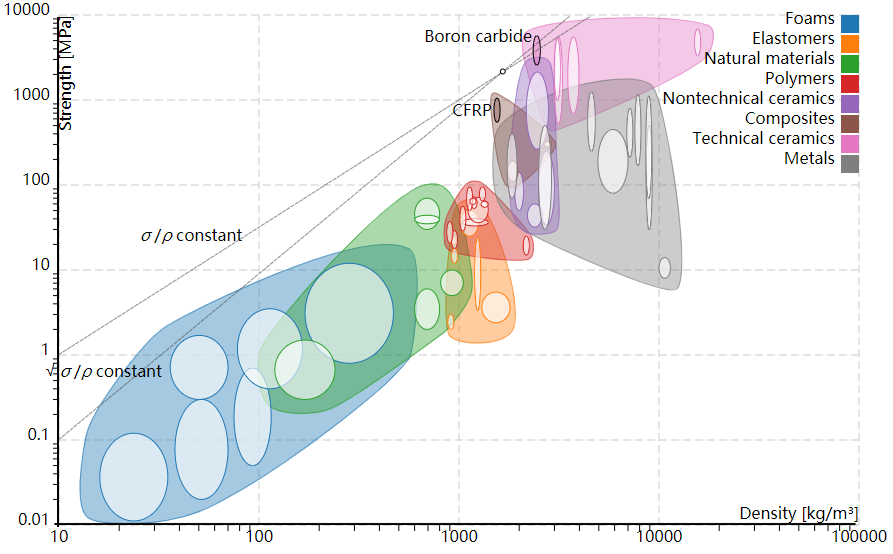
(Image from https://commons.wikimedia.org/wiki/File:SiSiC_nozzles.jpg)
Ceramic tools are typically heat and wear resistant which makes them suitable to machine metals that are extremely hard, and chemically stable. They are able to machine metals at high cutting speeds and in dry machining conditions because it is not required to decrease temperatures on the cutting edges of these tools.
However, they possess lower toughness as compared to carbide cutting tools. This disadvantage can be compensated by selecting an appropriate ceramic cutting grade and the type of tool. These tools have a base of alumina (Al2O3) and silicon nitride (Si3N4) compounds and are available in various grades that include ceramics mixed with other materials and reinforcing whisker materials to increase toughness.
Oxide ceramics

(Image from https://commons.wikimedia.org/wiki/File:Material-comparison–strength-vs-density_plain.svg)
For improvement of toughness, ceramic or cemented oxide tools, made primarily of alumina, are mixed with titanium, magnesium, chromium or zirconium oxides, or silicon-carbide grains. Cemented oxides are comparatively brittle and are suitable for rigid and vibration-free machines and setups.
Molding of materials takes place at about 4,000 psi and sintering at approximately 3,000 degrees F. This process helps attain high density and hardness in these tools. Oxide ceramics are used widely for rough and finish turning, grooving of gray and nodular cast iron, and continuous cutting at high speeds.
Extremely fine-grained silicon-carbide crystals that resemble the shape of whiskers are used to reinforce and increase the toughness of ceramic tools.
Reinforced ceramics process differently as compared to other cutting tools. They work by generating high temperatures ahead of the cutting tool to soften or plasticize the workpiece to be cut. Due to this, the removal of material becomes easy and a reduction in cutting forces is observed.
These tools require high surface speed and balanced feed rates. High speed is required to elevate the temperature in the shear zone and to ensure that the heat is transferred to the chip-forming zone immediately ahead of the cutter. With very slow cutting speeds, the heat generated is insufficient to soften the material in this zone, and the cutting forces are increased, leading to failure.
Whiskered ceramics are best suited for hard ferrous materials and nickel-base alloys that are difficult-to-machine, such as Inconel, Waspoloy, and Hastelloy. On the contrary, they are not suitable for ferrous alloys below Rc 42 hardness because of the chemical reaction that occurs between iron and the carbon that is part of the silicon carbide reinforcing material.
Silicon nitrides
Ceramics with a silicon nitride base offer high resistance to abrasion and thermal shock and possess high fracture toughness. These ceramic tools are like the shape of a needle that is embedded in a temperature resistant grain boundary. These structures improve crack deflection, crack bridging and pull-out effects, and lead to superior fracture toughness.
Methods used to produce these ceramics, including optimized powder processing and gas-sintering, help in the improvement of fracture toughness and high-temperature hardness. Silicon nitrides are highly suitable for cutting and milling rough machining cast iron. Additionally, they are suitable for milling operations where large cross-section chips are produced.
They have the capability to enable high speeds (more than 800 in./min.) and feed (0.2 to 0.3 in./min.) when coupled with powerful machine tools. For example, using these tools, gray cast iron, and nodular graphite cast iron can be milled at high speeds up to 800 in./min or sometimes 1,000 in./min.
These tools are fracture resistant, but due to their relatively low resistance to chemical wear, their use in machining nodular cast irons is limited.
(Written by John Hamlin)
声明:本文由 CERADIR 先进陶瓷在线平台的入驻企业/个人提供或自网络获取,文章内容仅代表作者本人,不代表本网站及 CERADIR 立场,本站不对文章内容真实性、准确性等负责,尤其不对文中产品有关功能性、效果等提供担保。本站提醒读者,文章仅供学习参考,不构成任何投资及应用建议。如需转载,请联系原作者。如涉及作品内容、版权和其它问题,请与我们联系,我们将在第一时间处理!本站拥有对此声明的最终解释权。









